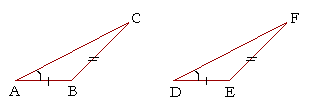|
Congruent Triangles
Side-side-angle is known as the ambiguous case. Consider triangles ABC, DEF. Let the angle at A be equal to the angle at D, side AB equal to side DE, and side BC equal to side EF. Then, if AB -- the side adjacent to the equal angles -- is less than or equal to BC (so that DE is also less than or equal to EF), then the two triangles are congruent. For, given those conditions, it is impossible to draw a triangle DEF that is not congruent to triangle ABC. However, if AB is greater than BC,
then it is possible to draw BG equal to BC -- and triangle ABG is not congruent to trangle ABC. Back to Some theorems of geometry Copyright © 2001-2007 Lawrence Spector Questions or comments? E-mail: themathpage@nyc.rr.com |

